50+ Beautiful House Ideas in 2024 | Innovative Concepts
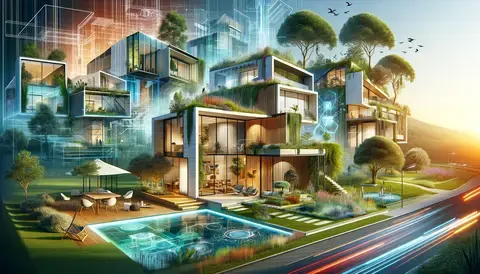
Vibrant and modern collage showcasing 2024 house designs, featuring ultra-modern structures and eco-friendly homes.
Welcome to our showcase of 2024's top house designs, where creativity and functionality merge seamlessly. This year, home design is all about personal expression and smart living, with over 50 innovative ideas ready to inspire your next project. Whether you're planning a state-of-the-art smart home or a peaceful natural retreat, this collection offers a range of stunning options to spark your creativity and help you dream big. Dive into this diverse array of homes that brilliantly blend aesthetic appeal with modern sustainability and smart technology.
➤ Fun Fact:
Did you know that "living walls" packed with plants are not just beautiful but also make homes more eco-friendly? By 2024, these green walls have become a popular feature in home design, improving both air quality and energy efficiency while adding a splash of style to any room.
In 2024, home design has soared to new levels with a wide range of styles, ideas, and technologies. Homeowners now choose from futuristic homes to classic designs, all reflecting personal style and comfort. Explore over 50 stunning house ideas that will spark your creativity and enhance your living space.
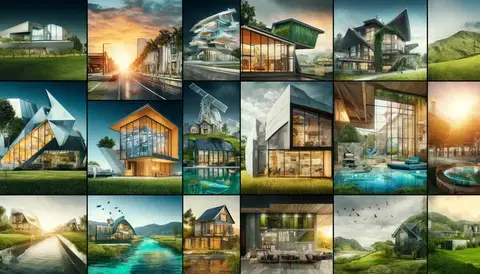
➤ How to Design a Modern Style House?
Designing a modern house combines aesthetic appeal with functionality, using clean lines, open spaces, and integrating the latest trends and technologies. Here’s a detailed exploration of how to design a modern style house, including key elements and tips for making the process engaging and informative.
1. Understanding Modern House Design Concept
- Design Concept: Modern house design emphasizes simplicity and function, featuring open floor plans, large windows, and minimalistic details. The focus is on creating airy, light-filled spaces that connect seamlessly with their surroundings.
2. Choosing the Best House Design
- Popular Styles: Among the most popular styles, modern minimalism stands out for its simplicity and emphasis on open space and natural light. Contemporary designs also remain popular, reflecting current trends and innovations.
- Planning Your Home: Start by listing your needs and desires. Consider factors like family size, lifestyle, and location. Use this list as a guide to sketch out the basic layout and features that best suit your life.
3. Interior Trends for 2024
- Trends to Watch: Look for bold monochromatics, sustainable materials, and advanced home automation systems. Textured finishes and multifunctional spaces are also trending, offering both style and practicality.
4. Key Elements of Modern House Architecture
- Key Elements: Think open layouts, minimal ornamentation, and extensive use of glass for natural light. Use materials like steel, concrete, and glass to express a sense of simplicity and sleekness.
5. Energy Efficiency in Modern Design
- Energy Efficiency: Modern designs often incorporate energy-efficient windows, solar panels, and smart thermostats. Good insulation and passive solar building design reduce energy consumption, making the home both modern and sustainable.
6. Technology in Modern Architecture
- Technological Innovations: Automated systems for lighting, heating, and security are becoming standard. Smart homes that allow homeowners to control various home systems remotely are on the rise.
7. Integrating with Nature
- Natural Integration: Use natural materials like wood and stone. Design large windows and outdoor living spaces that offer views and direct access to the outside, blurring the lines between indoor and outdoor living.
8. Cost-Effective Building Strategies
- Cost-Effective Methods: Modular construction and prefabricated elements can reduce costs and construction time. Choosing local materials and simplifying designs can also help manage the budget effectively.
9. Impact of Zoning on Design
- Zoning Considerations: Local zoning laws can affect everything from the house’s height to its setback from the street. Check local regulations early in the design process to avoid costly changes later.
10. Challenges in Construction - Overcoming Challenges: Common challenges include budget overruns, construction delays, and meeting building codes. Effective planning, a flexible budget, and clear communication with your architect and builder can mitigate these issues.
➤ Fun Fact: The first truly modern house was designed by architect Philip Johnson in 1949, known as the Glass House, for its use of glass walls that offer uninterrupted views of nature.
Fact: Modern architecture was once influenced heavily by the Bauhaus movement, which promoted functional design devoid of unnecessary adornments.
These elements and tips offer a comprehensive guide to designing a modern home that is both functional and stylish, blending with technological advancements and natural settings to create a comfortable, sustainable living environment.
Innovative Concepts of 50+ Beautiful House Ideas in 2024
Top 17 of the Innovative Concepts of 50+ Beautiful House
1.Modern Minimalism: Clean lines, sleek finishes, and open floor plans characterize this contemporary style, creating a sense of spaciousness and serenity.
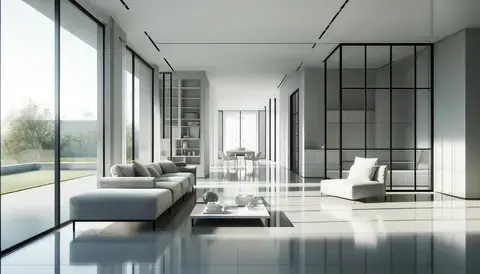
2. Smart Homes: Integration of cutting-edge technology enables seamless control of lighting, temperature, security, and entertainment systems, enhancing convenience and efficiency.
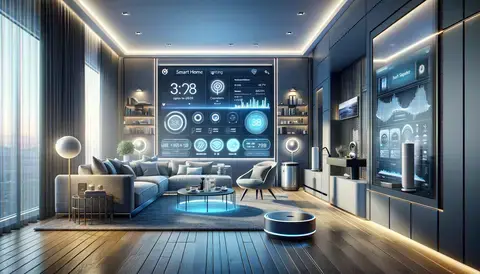
3. Sustainable Living: Embrace eco-conscious design principles with features such as solar panels, green roofs, rainwater harvesting systems, and energy-efficient appliances.
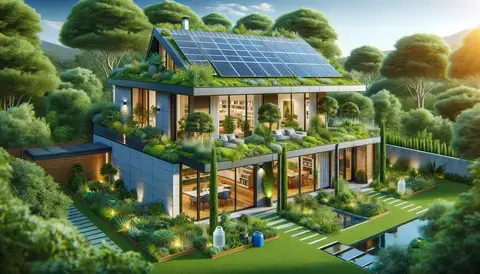
4. Cozy Cottages: Charming and quaint, these cottages exude warmth and character, with rustic details, cozy interiors, and inviting outdoor spaces.
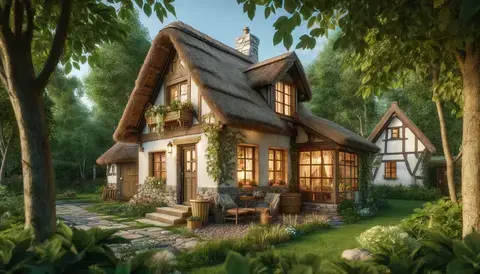
5. Luxurious Estates: Indulge in opulence with sprawling mansions featuring grand foyers, lavish amenities, and meticulously landscaped grounds.
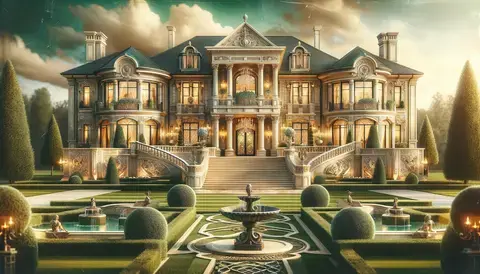
6. Mid-Century Modern: Pay homage to the iconic designs of the 1950s and 1960s with clean, organic forms, and minimalist aesthetics.
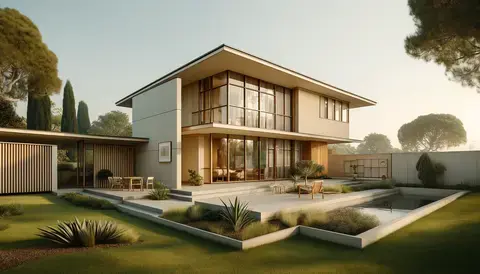
7. Farmhouse Chic: Blend rustic charm with contemporary elegance, incorporating reclaimed wood, farmhouse sinks, and shiplap accents.
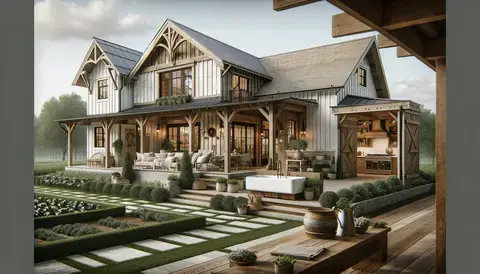
8. Urban Loft Living: Industrial-inspired lofts feature exposed brick, high ceilings, and expansive windows, creating a vibrant urban oasis.
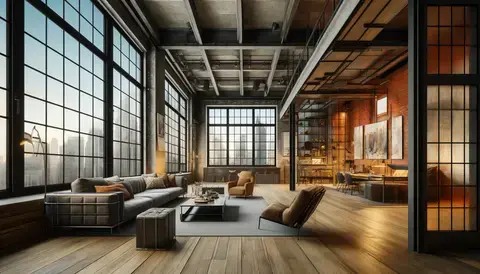
9. Mediterranean Retreats: Transport yourself to the sun-drenched coastlines of the Mediterranean with stucco exteriors, terra cotta roofs, and lush courtyards.
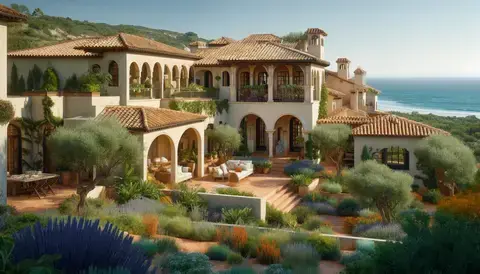
10. Beachfront Getaways: Embrace coastal living with beachfront residences boasting panoramic ocean views, expansive decks, and breezy interiors.
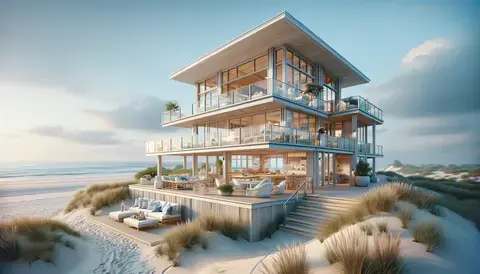
11. Treehouse Escapes: Nestle among the treetops in a whimsical treehouse retreat, blending seamlessly with nature and offering a tranquil escape from the hustle and bustle.
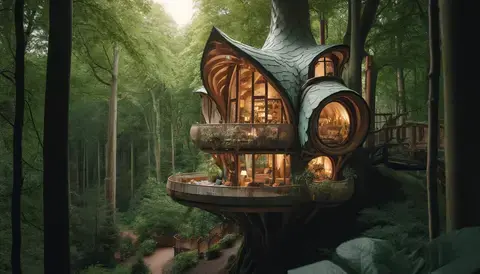
12. Japanese-Inspired Gardens: Create a serene sanctuary with minimalist landscaping, tranquil water features, and lush foliage, evoking the tranquility of a traditional Japanese garden.
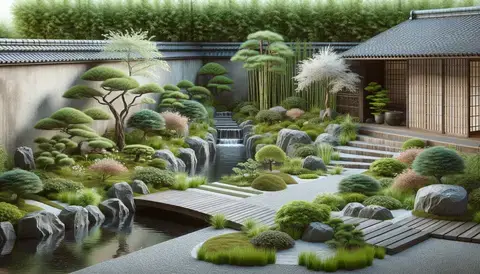
13.Scandinavian Design: Embrace the principles of simplicity, functionality, and comfort with Scandinavian-inspired interiors featuring clean lines, natural materials, and understated elegance.
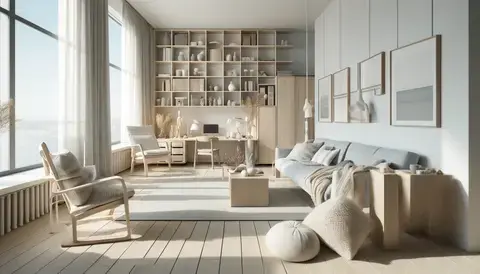
14. Victorian Revival: Pay homage to the past with ornate detailing, decorative trim, and wraparound porches, capturing the charm and romance of the Victorian era.
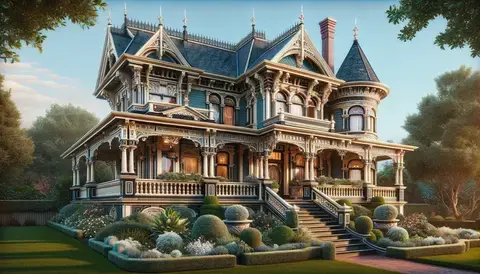
15. Contemporary Coastal Retreats: Blend modern design elements with coastal influences, incorporating nautical motifs, seaside hues, and breezy open layouts.
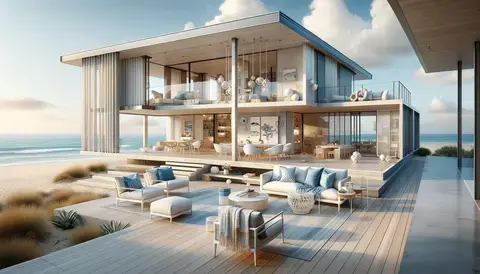
Tip: Expansive Windows in Modern Coastal Retreat : Incorporate smart glass windows, which can change from clear to opaque with the click of a button, providing privacy and energy efficiency.
16. Mountain Chalets: Cozy up in a mountain chalet retreat, featuring exposed timber beams, stone fireplaces, and expansive windows framing breathtaking alpine vistas.
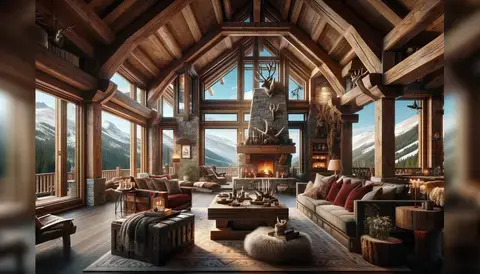
17. Art Deco House Elegance: Channel the glamour and sophistication of the Art Deco era with bold geometric patterns, luxurious materials, and sleek, streamlined forms.
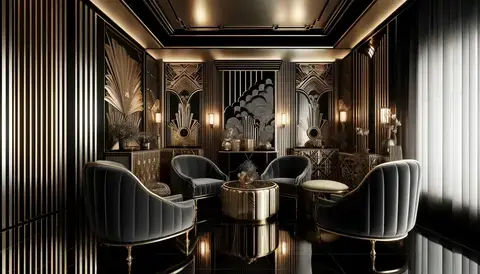
More Innovative Concepts | Delivering on Our Promise, Cutting-Edge House Ideas for 2024
Stylish Urban Innovations
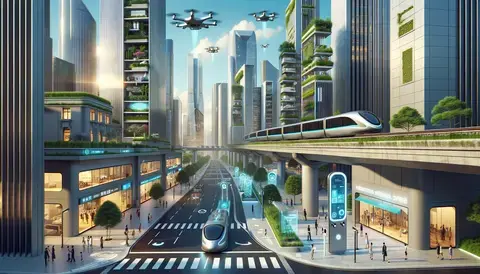
- Urban Townhouses: Enjoy the epitome of city living in townhouses with sleek designs, rooftop terraces for urban gardening or social events, and close proximity to metropolitan amenities.
- Urban Micro-Apartments: Optimize space in densely populated areas with micro-apartments that focus on smart storage solutions, compact efficiency, and a stylish aesthetic.
- Sky-High Penthouse Suites: Experience unrivaled luxury and privacy in penthouses that offer sweeping city views, high-end amenities, and a prestigious urban address.
Urban Farmhouses: Blend rural charm with urban convenience in farmhouse-style homes that feature modern amenities, open-concept living spaces, and expansive windows that frame views of the surrounding cityscape.
Urban Oasis: Create your own urban oasis with homes that feature private outdoor spaces, such as rooftop gardens, courtyard patios, or secluded balconies, providing a tranquil retreat from the hustle and bustle of city life.
Sustainable and Eco-Friendly Living
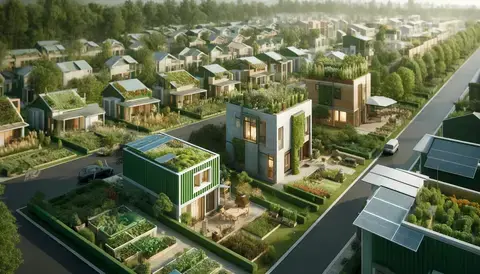
- Floating Homes: Live sustainably on the water in homes designed with buoyant foundations and eco-friendly materials, offering a unique connection to aquatic environments.
- Green Roof Retreats: Incorporate living landscapes atop homes to improve air quality, reduce water runoff, and enhance insulation.
- Solar-Powered Homes: Leverage the sun’s energy with solar panels and passive solar design, reducing reliance on fossil fuels and decreasing utility bills.
- Eco-Resorts: Stay in homes that prioritize low environmental impact and resource conservation, providing a guilt-free luxury experience.
Heritage and Architectural Beauty
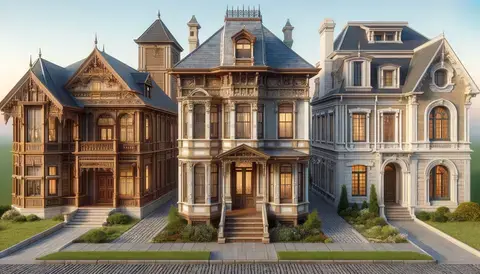
French Country Charm: Transport yourself to the French countryside with homes characterized by rustic stone facades, romantic balconies, and charming gardens filled with lavender and roses.
Historic Restorations: Preserve the past with lovingly restored historic homes, where period details and architectural charm are seamlessly integrated with modern amenities and conveniences.
Nature-Integrated Designs
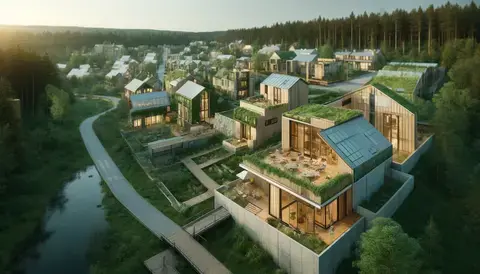
- Glass Houses: Embrace open, light-filled living spaces where the barriers between indoors and outdoors are blurred, offering panoramic views of the surrounding landscape.
- Atrium Houses: Center your home around a tranquil courtyard that brings natural light and greenery into the heart of your living space.
- Biophilic Design: Enhance well-being by integrating natural materials, plants, and water features into your home design, promoting a deeper connection with nature. Connect with nature in homes that embrace biophilic design principles, incorporating natural materials, organic shapes, and abundant greenery to enhance well-being, productivity, and harmony with the environment.
Floating Homes: Experience waterfront living in a floating home, where innovative design and sustainable materials come together to create a unique and eco-friendly dwelling.
Geodesic Domes: Embrace futuristic design with geodesic dome homes that offer structural strength, energy efficiency, and a unique, eye-catching aesthetic.
Floating Gardens: Experience the beauty of floating gardens, where lush vegetation and cascading water features create a serene and tranquil retreat on the water.
Unique Living Concepts
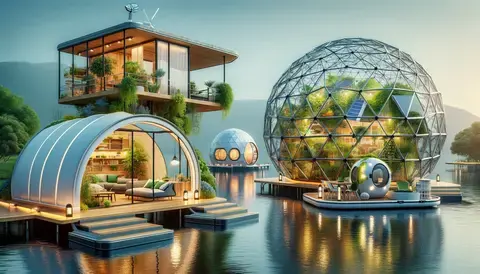
- Floating Gardens: Enjoy the serenity of floating gardens that offer a peaceful retreat with lush plants and flowing water, all while gently drifting on a lake or river.
- Geodesic Domes: Choose homes with a distinctive dome shape that provides structural stability, energy efficiency, and a striking visual appearance.
- Futuristic Pods: Embrace the future with modular pods that can be easily transported and configured to your living needs, offering a flexible and minimalist lifestyle.
Artistic Retreats: Celebrate creativity and self-expression with homes that serve as living canvases, featuring bold colors, eclectic furnishings, and gallery-worthy art collections.
Floating Villages: Explore the concept of floating villages, where interconnected homes and communal spaces create vibrant, water-based communities that adapt to changing water levels and environmental conditions.
Luxurious and Exclusive Retreats
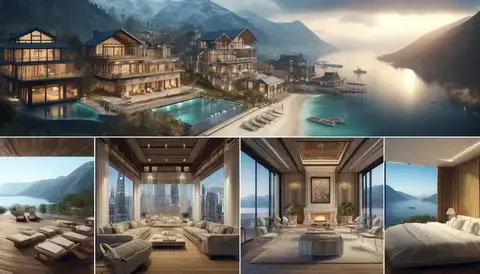
- Coastal Retreats: Live where the ocean meets the shore with homes that boast private beach access, expansive decks, and outdoor kitchens, perfect for relaxation and entertainment. Embrace transparency and light with glass-encased residences that blur the boundaries between indoor and outdoor spaces, offering panoramic views and a seamless connection to nature.
- Wellness Retreats: Prioritize your health and tranquility in homes designed with wellness in mind, featuring spaces for yoga, meditation, and spa-like treatments.
- Tropical Modernism: Blend the warm aesthetics of tropical design with the clean lines of modern architecture, creating spaces that are both stylish and comfortable in warm climates.
Tropical Paradise: Create your own tropical oasis with homes featuring lush gardens, outdoor living spaces, and natural materials that blur the line between indoor and outdoor living.
Atrium Houses: Bring the outdoors in with atrium-style homes that feature central courtyards filled with lush vegetation, natural light, and tranquil water features, creating a serene oasis in the heart of the home.
Community and Shared Living
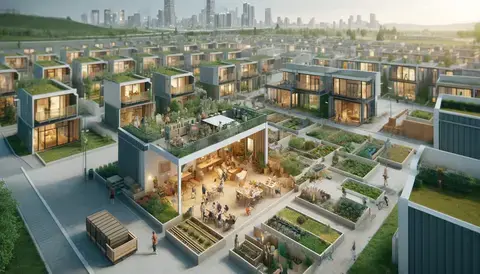
- Wellness Communities: Join a thriving community dedicated to health and well-being, with homes designed to promote active living, social connection, and environmental sustainability, fostering a sense of belonging and vitality for residents of all ages.
Wellness Retreats: Prioritize health and well-being with homes designed to promote relaxation, mindfulness, and connection to nature, featuring dedicated spaces for yoga, meditation, and spa treatments.
Community-Centric Living: Join a vibrant community of like-minded individuals with homes designed to foster social connection, collaboration, and shared experiences, featuring communal spaces, co-living arrangements, and shared amenities that promote a sense of belonging and camaraderie.
Cabin Escapes: Retreat to the wilderness with cozy cabin getaways featuring rustic interiors, wood-burning stoves, and panoramic views of the surrounding forest or mountains.
Innovative and Adaptive Housing
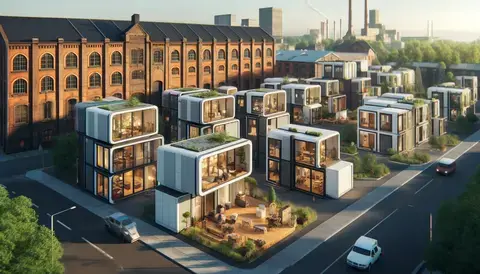
Adaptive Reuse: Celebrate the past with homes that repurpose historic buildings, industrial warehouses, or commercial spaces into unique and character-filled residences that honor their architectural heritage while embracing modern living.
Off-the-Grid Retreats: Escape the grid with off-the-grid retreats that offer self-sufficiency and independence, powered by renewable energy sources such as solar, wind, or hydroelectric power, and featuring rainwater collection systems, composting toilets, and sustainable building materials.
- Earthship Homes: Build a home that not only houses you but also grows your food, processes your waste, and generates your power. Embrace sustainable living with Earthship homes that utilize recycled materials, passive solar design, and off-grid systems to create self-sufficient and environmentally friendly dwellings that blend seamlessly with their natural surroundings.
Modern and High-Tech
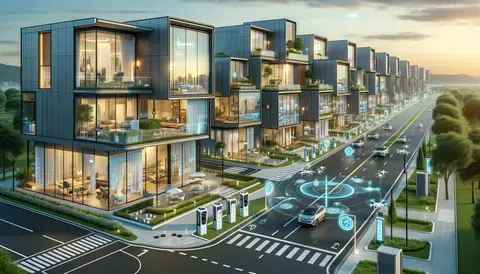
- Tech-Integrated Living: Stay ahead with homes equipped with the latest in smart technology, from AI-assisted living to automated systems and green technologies.
- Industrial Chic: Embrace the edginess of industrial aesthetics with lofts that feature raw textures like exposed brick and concrete, paired with chic, upcycled decor.
Modern Modular Homes: Embrace flexibility and sustainability with modern modular homes that can be customized and configured to suit your unique needs and preferences.
Compact and Efficient Living
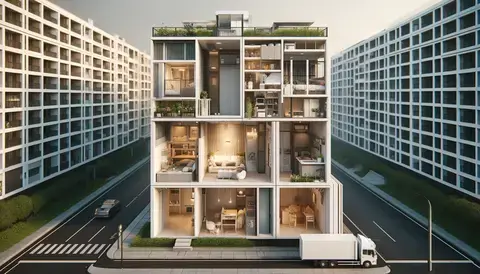
- Tiny Homes: Simplify your lifestyle in tiny homes that maximize space through clever designs, promoting efficiency and a minimal environmental footprint.
- Futuristic Pods: Adapt to the future with modular pods that offer compact and energy-efficient living spaces, designed for flexibility and easy adaptability.
Space-Efficient Apartments: Make the most of limited space with innovative apartment designs that prioritize functionality, flexibility, and style, offering clever storage solutions, multipurpose furniture, and customizable layouts to suit your needs.
Minimalist Sanctuaries: Embrace the beauty of simplicity with minimalist sanctuaries that feature clean lines, uncluttered spaces, and a neutral color palette, promoting a sense of calm, clarity, and serenity.
Cultural and Aesthetic Fusion
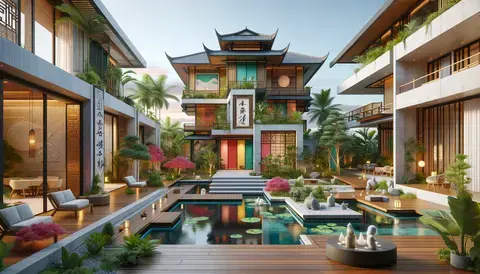
- Asian Fusion: Blend Eastern tranquility with Western modernity in homes that highlight minimalist aesthetics, clean lines, and peaceful garden spaces.
- Tropical Modernism: Incorporate elements of tropical design into modern architecture to enhance indoor-outdoor living and utilize natural ventilation and light.
Traditional and Transitional Styles
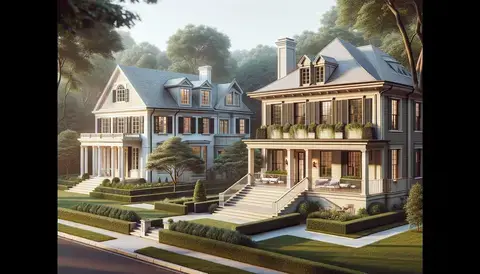
- Ranch Style Living: Embrace the expansive layouts and panoramic views of ranch-style homes, offering comfort and elegance with easy access to outdoor living.
- Transitional Design: Find the perfect balance in homes that mix the timeless charm of traditional aesthetics with the sleek functionality of contemporary design.
- Desert Retreats: Integrate your living space with the stark beauty of the desert in homes designed to complement and blend into the arid landscape with earth-toned exteriors and minimalist interiors.
Agricultural and Ecological
- Farm-to-Table Living: Engage directly with your food source in homes that feature gardens, orchards, and even livestock, supporting a sustainable, farm-to-table lifestyle.
Specialized Features
- Podcast Paradises: Create the perfect environment for podcasting and multimedia projects with homes that include soundproofed studios and high-tech equipment. Design your own podcast paradise with dedicated recording studios, soundproofing, and multimedia spaces that cater to your creative pursuits and passion projects, offering a sanctuary for inspiration, collaboration, and self-expression.
- Vintage Revivals: Celebrate the charm of past eras with homes that feature antique furnishings, classic decor, and a nostalgic atmosphere.
These 50+ house ideas represent just a glimpse of the endless possibilities available to homeowners in 2024. Whether you're drawn to contemporary elegance, timeless charm, or futuristic innovation, there's a perfect home waiting to be discovered, designed, and brought to life. Let these ideas inspire your imagination and guide you on your journey to creating the home of your dreams.
Stylish Living Room Ideas: Top Designs to Replicate or Adapt

Transforming your living room into a stylish and functional space can be both exciting and challenging. In this guide, we present top living room designs that you can easily replicate or adapt to suit your personal taste. Whether you prefer modern minimalist, Scandinavian cozy, or industrial chic, you'll find inspiration to create a living room that perfectly balances style and comfort.
House Design FAQs
A FAQ section where we get into the most common queries related to house design. This section aims to provide clear and detailed answers to help you navigate the complexities of designing your own home. Whether you're a first-time homeowner or a seasoned builder, these FAQs are designed to address your concerns and inspire your next project. We've organized the questions into relevant categories for easy navigation.
Show/Hide
Modern House Design FAQs
What is the Design Concept of a Modern House?
The design concept of a modern house focuses on simplicity, functionality, and the use of space. Characteristics include minimalistic aesthetics, clean lines, open floor plans, and large windows that bring in natural light and blur the boundary between indoors and outdoors. The materials often showcase industrial elements like steel, concrete, and glass.
How Can I Design My New Home? Which House Design is Best?
To design your new home:
- Identify Your Needs: Consider your lifestyle, family size, and any specific requirements such as home offices or outdoor spaces.
- Research and Inspiration: Gather ideas from architectural magazines, online resources, and by visiting homes.
- Consult Professionals: Work with an architect to bring your vision to reality, ensuring that your needs are met within budget and regulatory constraints.
The best house design is one that aligns with your lifestyle, budget, and the natural environment of the site.
What Style of Home is Most Popular? How to Plan a House?
Currently, modern and contemporary styles are highly popular due to their flexibility, openness, and emphasis on sustainability. To plan a house:
- Sketch Your Ideas: Begin with rough sketches of your desired floor plan.
- Site Analysis: Understand the geography, climate, and any building regulations of your plot.
- Detailed Design: Develop detailed blueprints with the help of an architect, considering structural requirements and aesthetic desires.
What are the Interior Trends for 2024?
Interior trends for 2024 include:
- Sustainability: Using eco-friendly materials and energy-efficient designs.
- Technological Integration: Smart home systems that enhance comfort and convenience.
- Natural Elements: Incorporation of plants, natural woods, and stones to create a serene, organic feel inside homes.
What are the Key Elements of Modern House Architecture?
Key elements of modern architecture include:
- Minimalism: Stripping down to essential components without excessive decoration.
- Open Spaces: Open floor plans that create a flow between living, dining, and kitchen areas.
- Natural Light: Large windows and sometimes glass walls to maximize light.
How do Energy Efficiency Considerations Impact Modern House Design?
Energy efficiency is central to modern design, involving:
- Insulation: High-quality insulation in walls, roofs, and floors.
- Energy-Efficient Windows: Triple-pane or treated glass to reduce heat loss.
- Orientation: Positioning the house to maximize natural heating and lighting, reducing reliance on artificial energy sources.
What Role do Technological Advancements Play in Modern Architecture?
Technological advancements streamline construction processes and enhance living conditions. They include:
- Building Information Modeling (BIM): Allows architects and engineers to create more accurate designs and troubleshoot problems before construction.
- Smart Homes: Automation in lighting, heating, and security systems for enhanced efficiency and convenience.
How Can Modern Designs Blend with the Natural Environment?
Modern designs can blend with the natural environment by:
- Using Local Materials: Reduces transportation costs and supports the local economy.
- Sustainable Practices: Such as rainwater harvesting and solar energy.
- Landscape Integration: Designing gardens and terraces that complement the natural surroundings.
What are Some Cost-Effective Strategies for Building a Modern House?
Cost-effective strategies include:
- Prefabrication: Using pre-made components to reduce construction time and waste.
- Simple Design: Minimalist designs require fewer materials and labor.
- Multi-functional Spaces: Reducing the overall footprint of the house.
How Does Zoning Affect Modern House Design?
Zoning regulations can dictate the size, height, and placement of buildings on a lot, affecting everything from the house's overall design to its orientation and landscaping. Compliance with local zoning laws is essential to avoid legal issues and redesigns.
What are Some Common Challenges in Modern House Construction and How Can They be Overcome?
Common challenges include:
- Cost Overruns: Maintain a contingency fund and closely monitor the budget.
- Delays: Schedule buffers and use reliable contractors.
- Regulatory Issues: Engage with local authorities early in the design process to ensure compliance.
These insights cover the comprehensive aspects of planning, designing, and building a modern home, tailored to the latest trends and personal needs while addressing practical challenges.
Luxury and Famous House Styles FAQs
Exploring luxury home design reveals a world of exceptional architecture, exquisite materials, and advanced amenities. Here’s an in-depth look at what defines a luxury style home, the most renowned examples, and the distinctive features that set them apart.
Show/Hide
What is a Luxury Style Home?
A luxury style home goes beyond standard living spaces, offering expansive layouts, high-end finishes, and exclusive amenities. These homes are characterized by meticulous architectural design, superior materials, and features that provide extraordinary comfort and aesthetic appeal.
What is the Most Famous House Style?
Among the most famous house styles globally, Victorian, Colonial, and Modernist homes stand out. However, iconic examples like Frank Lloyd Wright's Fallingwater (Modernist) and the grand estates of the English Tudor style are also profoundly influential.
Which House is No. 1 in the World? What is the Most Luxurious Type of House?
While it's subjective to determine the "No. 1" house in the world due to different criteria like size, price, or architectural significance, places like Buckingham Palace or the Antilia in Mumbai (a private residence) are often noted for their grandeur and luxurious attributes.
What is the Most Beautiful House in the World?
Beauty in architecture is subjective, but the Villa Leopolda on the French Riviera is often cited. This sprawling estate is renowned for its historic architecture, luxurious gardens, and spectacular views.
How do Luxury Home Designs Differ from Other Home Styles?
Luxury home designs distinguish themselves through:
- Scale and Layout: Larger in size with multiple living spaces, bedrooms, and bespoke areas like home theaters or gyms.
- High-end Materials: Utilizing premium materials such as marble, exotic woods, and designer textiles.
- Advanced Amenities: Featuring state-of-the-art kitchen appliances, spa-like bathrooms, and integrated smart home technology.
What Materials are Commonly Used in Luxury Home Construction?
Luxury homes often use materials such as:
- Natural Stone: Marble, granite, and limestone for flooring and decorative features.
- Exotic Woods: Teak, mahogany, and cherry for flooring, paneling, and built-ins.
- High-End Metals: Brass, copper, and brushed nickel for fixtures and details.
What Features are Typically Included in the World’s Most Luxurious Houses?
Features often include:
- Spa and Wellness Centers: Personal spas, saunas, and indoor pools.
- Entertainment Zones: Custom home theaters, game rooms, and elaborate outdoor living areas.
- Smart Home Systems: Comprehensive home automation for security, climate control, and entertainment.
How are Famous House Styles Preserved and Maintained?
Preservation of famous house styles involves:
- Regular Maintenance: Specialized upkeep to protect structural and aesthetic integrity.
- Restoration Projects: Using historically accurate materials and methods to maintain authenticity.
- Legal Protections: Many iconic homes are designated as historical landmarks, requiring adherence to strict guidelines for any modification.
What Legal Considerations Come with Owning a Luxury or Famous House?
Legal considerations can include:
- Zoning Laws: Compliance with local zoning regulations which may dictate land use and building appearances.
- Privacy Laws: Security measures that comply with legal standards without infringing on privacy rights.
- Historical Status: Adhering to regulations if the property is a designated historical landmark.
Can Luxury Homes Also be Environmentally Friendly?
Absolutely. Many luxury homes incorporate:
- Sustainable Materials: Eco-friendly materials and construction techniques.
- Energy Efficiency: High-efficiency systems and renewable energy sources like solar or geothermal.
- Landscaping: Using native plants to reduce water usage and enhance the local ecosystem.
What are the Latest Trends in Luxury Home Design?
Current trends include:
- Biophilic Design: Integrating natural elements into home design to create a more organic and healthy environment.
- Minimalist Luxury: Simplified luxury focusing on space and light over opulence.
- Technological Integration: Advanced smart home technologies for enhanced comfort and security.
Luxury homes epitomize the pinnacle of residential architecture and design, combining advanced technology, exclusive materials, and tailored features to create spaces that are both grand and habitable.
Home Style Selection and Planning FAQs
Choosing a house style is a significant decision that impacts not only the aesthetics of your home but also its functionality and adaptability to your lifestyle. Here’s a comprehensive guide to help you make an informed choice.
Show/Hide
How Do I Choose a House Style?
- Assess Your Needs: Consider your family size, lifestyle, and preferences. Do you entertain often? Do you need a home office? Answering these questions can help guide your style choice.
- Architectural Appeal: Look for styles that you find visually appealing and that evoke a sense of comfort and belonging.
What Factors Should Be Considered When Selecting a House Style?
- Lifestyle Compatibility: Ensure the style meets your daily living needs.
- Budget: Some styles are more complex and costly to build.
- Resale Value: Consider popular styles in your area that might help in resale.
- Longevity: Choose a style that you will love for many years, not just a passing trend.
How Does Location Influence the Choice of House Style?
- Climate: In colder regions, a house with a steep roof (like a chalet) can help shed snow, whereas in warmer climates, a style with larger windows and verandas might be preferable.
- Cultural Norms: Local architectural styles can reflect cultural heritage and might be more appealing or appropriate.
- Natural Landscape: A house style should complement its surroundings, such as a beach house style for seaside properties.
What are the Pros and Cons of Popular House Styles?
- Modern: Pros include clean lines and large windows; cons can be the colder, less cozy feel and sometimes higher costs due to materials.
- Colonial: Pros are traditional aesthetics and formal layouts; cons include potentially less efficient use of space.
- Craftsman: Pros include custom woodwork and sturdy construction; cons might be higher maintenance requirements.
How Can Personal Taste Be Balanced With Market Trends in House Style Selection?
- Research: Stay informed about current trends and consider how they can be integrated into styles you love.
- Flexibility: Incorporate elements of trends in ways that are easily changeable, like interior decorations or landscaping rather than structural changes.
- Timelessness: Focus on timeless elements that can withstand passing trends.
How to Ensure Your Chosen House Style Suits Your Lifestyle Needs?
- Functionality Testing: Imagine your daily activities in the floor plan. Does it flow logically? Are there enough rooms/spaces for your activities?
- Future Planning: Consider future needs such as family expansion or possible downsizing.
- Consult Professionals: Architects and designers can provide insights into how a style can be adapted to suit your needs.
What Resources Are Helpful in Visualizing Different House Styles Before Making a Decision?
- Architectural Software: Tools like SketchUp or AutoCAD can help visualize designs.
- Virtual Tours: Many real estate websites offer virtual tours of homes in different styles.
- Magazines and Books: Architectural magazines and books provide high-quality visuals and expert insights.
How Can Historical Architectural Styles Be Adapted to Modern Needs?
- Modern Conveniences: Integrate modern technologies and materials into the build while maintaining historical aesthetics.
- Energy Efficiency: Upgrade insulation, windows, and HVAC systems to meet current standards.
- Space Reconfiguration: Adjust room functions and layouts to fit contemporary lifestyles, such as turning a formal parlor into a home office.
Selecting a house style involves balancing personal preferences with practical considerations, ensuring the home not only looks appealing but also fits well with your lifestyle, the environment, and future marketability.
Interior Design and Beautification FAQs
Interior design transforms a space not only to make it look appealing but also to enhance its functionality and comfort. Here's how you can approach designing and beautifying your home, focusing on different aspects of interior design.
Show/Hide
How to Interior Design a House?
- Plan Your Space: Assess each room’s purpose and layout. Use floor plans to allocate space effectively.
- Style Selection: Choose a design style that reflects your personality and lifestyle, such as modern, minimalist, or traditional.
- Color Scheme: Decide on a color palette that sets the desired mood and unifies different areas of the home.
- Furniture and Decor: Select furniture that fits the scale of the room and choose decor that complements the overall design.
- Final Touches: Add artwork, lighting, and accessories to enhance the space’s aesthetics and functionality.
How to Beautify a Living Room?
- Focal Point: Establish a focal point such as a fireplace, a large window, or an artwork.
- Comfortable Seating: Arrange seating that promotes conversation and comfort.
- Layered Lighting: Use a mix of ambient, task, and accent lighting to create a warm and inviting atmosphere.
- Personal Touches: Incorporate personal items like family photos or heirlooms to make the space feel welcoming.
What are the Principles of Effective Interior Design?
- Balance: Distribute visual weight evenly throughout the room.
- Rhythm: Create visual rhythm through repetition of colors, patterns, or textures.
- Harmony: Ensure all elements in a space work together cohesively.
- Emphasis: Highlight key features or areas within a room.
- Proportion and Scale: Match items and furniture sizes to the scale of the space.
How Can Small Spaces Be Designed to Feel Larger?
- Light Colors: Use light colors on walls and floors to make a room feel bigger.
- Mirrors: Place mirrors strategically to reflect light and create an illusion of space.
- Multi-functional Furniture: Opt for furniture that can serve multiple purposes, like a bed with storage underneath.
- Declutter: Keep the space tidy and free of unnecessary items.
Best Practices for Choosing Color Schemes in Home Interiors
- Color Wheel: Use the color wheel to identify complementary and analogous color schemes.
- 60-30-10 Rule: Apply colors in the proportion of 60% dominant color, 30% secondary color, and 10% accent color.
- Mood Creation: Choose colors based on the mood you want to set in each room, such as calming blues for a bedroom or energizing yellows for a kitchen.
How to Integrate Smart Home Devices Aesthetically into Interior Design?
- Concealment: Hide devices within furniture or behind decorative elements.
- Color Matching: Choose devices that match the room’s color scheme or are designed to be discreet.
- Functional Decor: Use smart devices that also serve as decor, like stylish smart lamps.
Budget-Friendly Interior Design Tips
- DIY Projects: Take on DIY projects like painting or crafting your own decor.
- Thrift and Vintage: Shop at thrift stores or flea markets for unique, affordable pieces.
- Repurpose: Reuse and repurpose old furniture or decor items in new ways.
How Can Artwork Be Used to Enhance the Aesthetics of a Home?
- Statement Pieces: Use large pieces as focal points in rooms.
- Gallery Walls: Create a gallery wall with various sizes and styles of art to draw interest.
- Thematic Continuity: Choose art that complements the theme and color scheme of your home.
What Role Does Lighting Play in Interior Design?
- Functionality: Ensure sufficient lighting for tasks, especially in kitchens and offices.
- Mood Setting: Use dimmers and varied light sources to create different moods and atmospheres.
- Aesthetic Enhancement: Choose light fixtures that act as decorative elements as well as lighting sources.
Incorporating these elements and approaches into your interior design can help create a space that is not only beautiful but also functional and reflective of your personal style.
Architectural Planning and 3D Design FAQs
The process of architectural planning combined with the power of 3D design software can greatly enhance the efficiency, aesthetics, and functionality of building a house. Here's an in-depth guide covering the key aspects of these processes.
Show/Hide
How to Architect a House?
- Client Briefing: Understand the client's requirements, budget, and preferences.
- Site Analysis: Evaluate the site for its environment, topography, and legal constraints.
- Conceptual Design: Sketch preliminary designs and floor plans based on the client's needs and the site analysis.
- Detailed Design and Documentation: Develop detailed drawings and specifications for construction.
- Approval and Permits: Obtain necessary approvals and permits from local authorities.
- Construction Oversight: Oversee the construction process to ensure that it adheres to the plans.
What is 3D Design of a House?
3D design of a house involves creating digital models of the house in three dimensions. This method allows both architects and clients to visualize the space better, understand material impacts, and simulate environmental effects on the building before construction begins.
Steps Involved in the Architectural Planning of a House
- Needs and Goals Definition: Collect all requirements from the client.
- Preliminary Design: Create initial design concepts.
- Design Development: Refine chosen concepts into detailed plans.
- Construction Documentation: Produce detailed drawings and documents for builders.
- Construction Administration: Manage the construction process to align with the architectural plans.
How Can 3D Design Software Be Used to Optimize House Planning?
3D design software can optimize house planning by:
- Spatial Visualization: Allowing better understanding of spatial proportions and layouts.
- Sun and Light Studies: Conducting simulations to see how light interacts with the building at different times of the day or year.
- Material and Cost Estimation: Helping in accurate material specification and cost estimation.
- Iterative Design: Making it easier to make and view changes based on client feedback or practical requirements.
Benefits of Using 3D Modeling in House Design
- Improved Visualization: Clients can see realistic representations of their home before it's built.
- Error Reduction: Potential design conflicts can be spotted and resolved before construction starts.
- Enhanced Communication: Facilitates clearer communication between all parties involved.
- Integration with Other Technologies: Can be combined with VR for immersive previews or with BIM for detailed project management.
How to Choose the Right Architect for Your Home Project?
- Experience and Portfolio: Review their past projects and expertise in the style you want.
- Client Reviews and Feedback: Look for reviews or ask for client references.
- Communication Style: Ensure their communication style matches your expectations.
- Professional Credentials: Verify their licensing and professional standings.
Common Pitfalls in House Architecture and How to Avoid Them
- Overlooking User Needs: Constantly refer back to the client’s needs throughout the project.
- Ignoring Site Characteristics: Tailor the design specifically to the advantages and limitations of the site.
- Budget Overruns: Regularly review the budget and adjust designs to stay within financial limits.
How Does 3D Design Facilitate Client-Architect Communication?
3D design helps in:
- Visual Feedback: Clients can view changes and provide feedback more effectively.
- Decision Making: Helps in making decisions about materials, colors, and layouts.
- Expectation Management: Reduces discrepancies between client expectations and the final product.
Future Technologies That Could Change House Architecture
- Virtual Reality (VR): Offers immersive design experiences and walkthroughs.
- Artificial Intelligence (AI): Can predict design trends and optimize layouts.
- Advanced Building Materials: New materials with enhanced properties like better insulation or strength could redefine structural possibilities.
Using 3D design in architectural planning enhances understanding, accuracy, and efficiency, paving the way for smoother construction processes and more successful project outcomes.
These FAQs are tailored to provide you with in-depth knowledge and practical advice on a wide range of topics related to house design, from choosing the right style to implementing the latest trends in luxury and modern architecture. Whether you’re planning your dream home or just curious about the architectural process, this section offers valuable insights into creating beautiful and functional living spaces.
